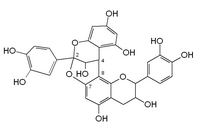A type proanthocyanidins are a specific type of proanthocyanidins, which are a class of flavonoid. Proanthocyanidins fall under a wide range of names in the nutritional and scientific vernacular, including oligomeric proanthocyanidins, flavonoids, polyphenols, condensed tannins, and OPCs. Proanthocyanidins were first popularized by French scientist Jacques Masquelier.
Distribution in plants

A-type linkage is a less common feature in proanthocyanidins with both 4β→8 (B-type) and 2β→O→7 interflavanoid bonds.
A-type proanthocyanidin glycosides can be isolated from cocoa liquor.
Dimers
- Procyanidin A1 is an epicatechin-(2β→7,4β→8)-catechin dimer.
- Procyanidin A2 is a dimeric (-)epicatechin.
Other A-type proanthocyanidins can be found in cranberries, cinnamon, peanut skins and Geranium niveum.
Chemistry
B-type procyanidins (catechin dimers) can be converted to A-type procyanidins by radical oxidation. Fragmentation patterns for A-type proanthocyanidins include heterocyclic ring fission (HRF), retro-Diels-Alder (RDA) fission, benzofuran-forming fission (BFF) and quinone methide fission (QM).
Metabolism
The metabolism of type-A proanthocyanidins is significant since a large number of metabolites are detected in urine and feces soon after ingestion of foods rich in polymers, indicating rapid elimination and absence of physiological effect. Polymeric type-A proanthocyanidins are depolymerized into epicatechin units in the small intestine, then cleaved into smaller phenolic acids with no known biological role.
Research
In vitro, A-type proanthocyanidins isolated from cranberry juice cocktail demonstrated anti-adhesion activity against E. coli binding to urinary tract epithelial cells, whereas B-type proanthocyanidins from grape exhibited minor activity. In humans, a 2014 review indicated there was insufficient clinical evidence that cranberry type-A proanthocyanidins are effective in lowering the risk of urinary tract infections (UTIs), while a 2023 review concluded that long-term consumption of cranberry products may reduce the risk of UTIs in certain groups.
References
- Fine, AM (2000). "Oligomeric proanthocyanidin complexes: history, structure, and phytopharmaceutical applications" (PDF). Alternative Medicine Review. 5 (2): 144–51. PMID 10767669. Archived from the original (PDF) on 4 November 2009. Retrieved 22 September 2009.
- ^ Neto, CC (2007). "Cranberry and its phytochemicals: a review of in vitro anticancer studies". The Journal of Nutrition. 137 (1 Suppl): 186S – 193S. doi:10.1093/jn/137.1.186S. PMID 17182824.
- Hatano, T; Miyatake, H; Natsume, M; Osakabe, N; Takizawa, T; Ito, H; Yoshida, T (2002). "Proanthocyanidin glycosides and related polyphenols from cacao liquor and their antioxidant effects". Phytochemistry. 59 (7): 749–58. doi:10.1016/S0031-9422(02)00051-1. PMID 11909632.
- María Luisa Mateos-Martín; Elisabet Fuguet; Carmen Quero; Jara Pérez-Jiménez; Josep Lluís Torres (2012). "New identification of proanthocyanidins in cinnamon (Cinnamomum zeylanicum L.) using MALDI-TOF/TOF mass spectrometry". Analytical and Bioanalytical Chemistry. 402 (3): 1327–1336. doi:10.1007/s00216-011-5557-3. hdl:10261/88579. PMID 22101466.
- de Camargo, A. C.; Regitano-d'Arce, M. A. B.; Gallo, C. R.; Shahidi, F. (2015). "Gamma-irradiation induced changes in microbiological status, phenolic profile and antioxidant activity of peanut skin". Journal of Functional Foods. 12: 129–143. doi:10.1016/j.jff.2014.10.034.
- Hongxiang Lou; Yamazaku Y.; Sasaku T.; Uchida M.; Tanaka H.; Oka S. (1999). "A-type proanthocyanidins from peanut skins". Phytochemistry. 51 (2): 297–308. doi:10.1016/S0031-9422(98)00736-5.
- Calzada, F; Cerda-García-Rojas, CM; Meckes, M; Cedillo-Rivera, R; Bye, R; Mata, R (1999). "Geranins a and B, new antiprotozoal A-type proanthocyanidins from Geranium niveum". Journal of Natural Products. 62 (5): 705–9. doi:10.1021/np980467b. PMID 10346950.
- Kondo, Kazunari; Kurihara, Masaaki; Fukuhara, Kiyoshi; Tanaka, Takashi; Suzuki, Takashi; Miyata, Naoki; Toyoda, Masatake (2000). "Conversion of procyanidin B-type (catechin dimer) to A-type: Evidence for abstraction of C-2 hydrogen in catechin during radical oxidation". Tetrahedron Letters. 41 (4): 485–488. doi:10.1016/S0040-4039(99)02097-3.
- Li, Hui-Jing; Deinzer, Max L. (2008). "The mass spectral analysis of isolated hops A-type proanthocyanidins by electrospray ionization tandem mass spectrometry". Journal of Mass Spectrometry. 43 (10): 1353–63. doi:10.1002/jms.1411. PMID 18416438.
- María Luisa Mateos-Martín; Jara Pérez-Jiménez; Elisabet Fuguet; Josep Lluís Torres (2012). "Profile of urinary and fecal proanthocyanidin metabolites from common cinnamon (Cinnamomum zeylanicum L.) in rats". Mol. Nutr. Food Res. 56 (4): 671–675. doi:10.1002/mnfr.201100672. hdl:10261/88578. PMID 22383303.
- Howell AB, Reed JD, Krueger CG, Winterbottom R, Cunningham DG, Leahy M (2005). "A-type cranberry proanthocyanidins and uropathogenic bacterial anti-adhesion activity". Phytochemistry. 66 (18): 2281–91. doi:10.1016/j.phytochem.2005.05.022. PMID 16055161.
- "Scientific Opinion on the substantiation of a health claim related to CranMax® and reduction of the risk of urinary tract infection by inhibiting the adhesion of certain bacteria in the urinary tract pursuant to Article 14 of Regulation (EC) No 1924/20061". EFSA Journal. 12 (5): 3657. 2014. doi:10.2903/j.efsa.2014.3657.
- Williams, Gabrielle; Hahn, Deirdre; Stephens, Jacqueline H.; Craig, Jonathan C.; Hodson, Elisabeth M. (17 April 2023). "Cranberries for preventing urinary tract infections". The Cochrane Database of Systematic Reviews. 4 (4): CD001321. doi:10.1002/14651858.CD001321.pub6. ISSN 1469-493X. PMC 10108827. PMID 37068952.
| Types of procyanidins | |
|---|---|
| A-type proanthocyanidins |
|
| B type proanthocyanidins |
|
| Types | |